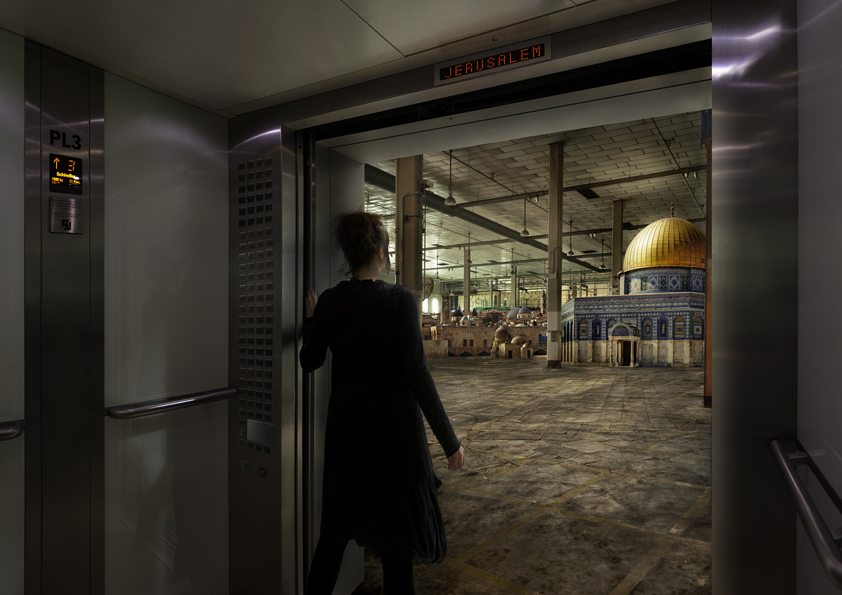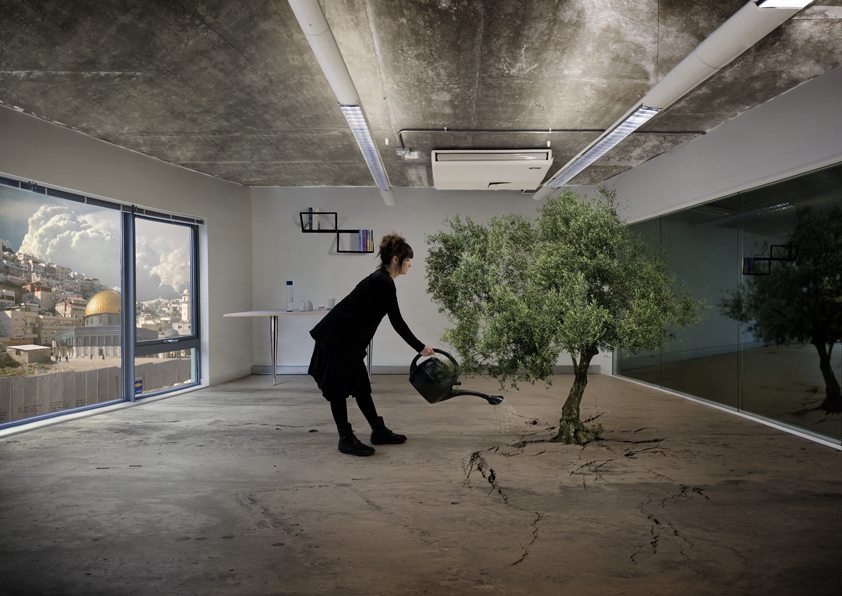A talk with Larissa Sansour
The high life

Born in Jerusalem, Palestinian artist Larissa Sansour is the author of numerous photo essays and videos. From A Space Exodus in which she stages herself as a cosmonaut landing on the moon, planting the Palestinian flag in the ground, to Falafel Road, a journey through the history of the Palestinian falafel, all of her works question the notion of Palestinian identity.
Can you tell us more about your film and photo project, Nation Estate? Where will it be displayed?
The Nation Estate project is a sci-fi photo series conceived in the wake of the Palestinian bid for nationhood at the UN. I developed three preliminary sketches especially for the Lacoste Elysée Prize. Encouraged to approach the theme of the competition, ‘la joie de vivre’, indirectly or even with irony, I decided on a slightly dystopic approach. Set within a grim piece of hi-tech architecture, this narrative photo series entitled Nation Estate envisions ‘la joie de vivre’ of a Palestinian state rising from the ashes of the peace process.
My Nation Estate project offers a vertical solution to statehood. When I first got the idea for the project, its working title was Living the High Life.
In this vision, Palestinians have their state in the form of a single skyscraper — the Nation Estate. Surrounded by a concrete wall, this colossal high-rise houses the entire Palestinian population — finally living the high life. Each city has its own floor: Jerusalem, third floor; Ramallah, fourth floor. Intercity trips previously marred by checkpoints are now made by elevator. Aiming for a sense of belonging, the lobby of each floor reenacts iconic squares and landmarks — elevator doors on the Jerusalem floor opening onto a full-scale Dome of the Rock. Built just outside the actual city of Jerusalem, the building has views of the original golden dome from the top floors.

I have a solo exhibition in Copenhagen, Denmark, in August 2012. This is where the Nation Estate project in its entirety was originally scheduled to be launched. The Musée de l’Elysée has also offered to show the work once it is done, but no formal agreement has yet been made — as we all need to assess the scope and implications of the whole controversy.
Why did you choose to represent Palestine in the shape of a skyscraper? What does one has in common with the other?
The idea came about as a result of a conversation about Israeli settlements and land confiscation several years ago. With vast amounts of Palestinian land confiscated and used for settlement construction, it seemed virtually impossible to fit this potential Palestinian nation anywhere. My Nation Estate project offers a vertical solution to statehood. When I first got the idea for the project, its working title was Living the High Life.
Every year, I hope next year will be the year of Palestine.
Do you think 2012 could be the year of Palestine?
Every year, I hope next year will be the year of Palestine. Earlier this year when Palestine submitted its application for full membership at the UN and received a standing ovation in the General Assembly, I had very high hopes. But now the outlook is once again a bit less cheerful, I think. 2012 seeing an American election makes it hard to imagine any real pressure on Israel, and my fears are that business as usual will prevent any kind of significant deal from being reached.
For now, being Palestinian is closely linked to being political, for better and for worse.
Is it realistic to imagine that the work of a Palestinian artist could be detached from any political reference or from any form of commitment?
Palestinian work tends to be very political, and most institutions showing Palestinian artists are interested in this approach. This does not mean, however, that artists produce political work in order to meet expectations. For all Palestinians, politics is not just an option, but a fundamental circumstance. In the current political climate, I find it hard to imagine Palestinian artists not being associated with the politics that surround them. This doesn’t mean that it’s impossible, of course, but for now, being Palestinian is closely linked to being political, for better and for worse.

The Washington Post, The Guardian, The independent, BBC World, The Hollywood reporter and so on, interviewed you after the Lacoste scandal erupted. Why do you think this story caught the Western media’s attention?
Lacoste being quite a famous clothing brand probably made a big difference. Even so, the massive attention the story got came as a complete surprise to me. What I quickly decided was that I could not just accept their decision to remove my work in silence. And the obvious censorship on political grounds simply seems to have struck a note with most people hearing the story.
It is also a very clear-cut illustration of a violation of artistic freedom, and the episode certainly raises a lot of questions about corporate involvement in the arts. I think what made this story so widely covered is the wide audience who related to it, ranging from Palestinians and political activists to artists, journalists and others around the world. This incident touches upon many issues, human rights, censorship and freedom of artistic expression.
In the end, I was very happy to see them do the right thing and side with the artist instead of the corporate sponsor.
Did you expect the museum of Lausanne to side with you, the artist, and not with its initial sponsor?
No, not at all. In fact, when I released my statement, I was quite certain that they would not side with me. I was informed that the decision to remove me was final, and that the prize would simply go on without me. So initially, the museum might have resisted and regretted Lacoste’s demands, but they still somehow at least tentatively submitted to them. It was not until after the overwhelming amount of reactions from the public and the media that they decided to distance themselves from their sponsor and side with the artist. And better late than never, of course. I also do understand that Lacoste put the museum in a difficult position. In the end, I was very happy to see them do the right thing and side with the artist instead of the corporate sponsor.
2 thoughts on “A talk with Larissa Sansour”
Comments are closed.








I can’t hear anything over the sound of how awesome this article is.